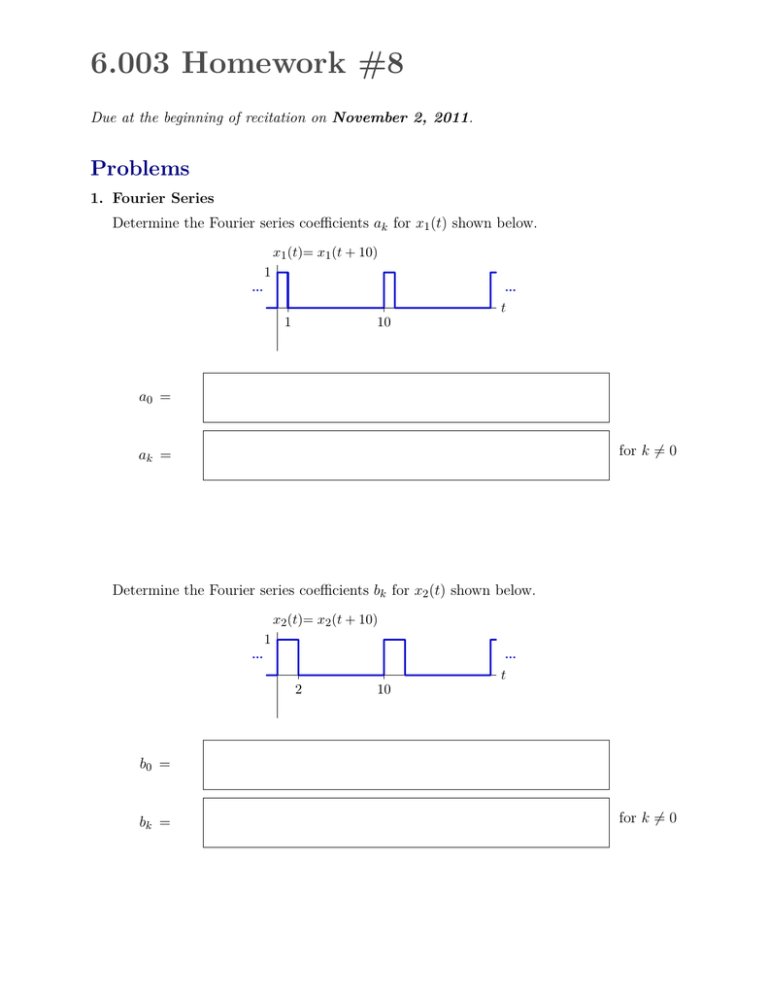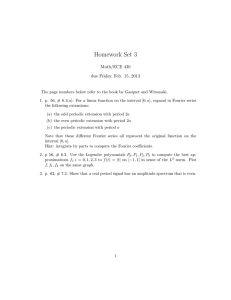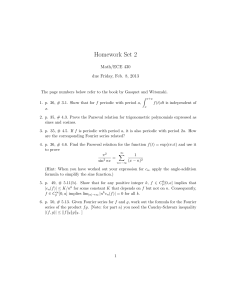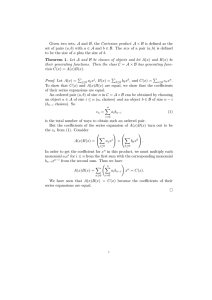6.003 Problems Due a
advertisement

6.003 Homework #8 Due at the beginning of recitation on November 2, 2011. Problems 1. Fourier Series Determine the Fourier series coefficients ak for x1 (t) shown below. x1 (t)= x1 (t + 10) 1 t 1 10 a0 = for k = 0 ak = Determine the Fourier series coefficients bk for x2 (t) shown below. x2 (t)= x2 (t + 10) 1 t 2 10 b0 = bk = for k = 0 6.003 Homework #8 / Fall 2011 2 Determine the Fourier series coefficients ck for x3 (t) shown below. x3 (t)= x3 (t + 10) 1 23 1 t 10 −1 c0 = for k = 6 0 ck = Determine the Fourier series coefficients dk for x4 (t) shown below. x4 (t)= x4 (t + 10) 1 t 123 10 d0 = dk = for k 6= 0 6.003 Homework #8 / Fall 2011 3 2. Inverse Fourier series Determine the CT signals with the following Fourier series coefficients. Assume that the signals are periodic in T = 4. Enter an expression that is valid for 0 ≤ t < 4 (other values can be found by periodic extension). a. ak = jk; |k| < 3 0 otherwise x(t) = b. bk = for 0 ≤ t < 4. 1; k odd 0; k even x(t) = for 0 ≤ t < 4. 6.003 Homework #8 / Fall 2011 4 3. Matching Consider the following Fourier series coefficients. bk = ak 1 3 j2k 0 k = ±1, ±2, ±4, ±5, ±7, . . . k = 0, ±3, ±6, · · · 1 k ck k dk 1 1 k ek k fk 1 1 k a. Which coefficients (if any) corresponds to the following periodic signal? x1 (t) = 2 − 2 cos 2π t 3 ak , bk , ck , dk , ek , fk , or None: k 6.003 Homework #8 / Fall 2011 5 b. Which coefficients (if any) corresponds to the following periodic signal with period T = 3? x2 (t) 2 −6 −3 0 3 6 t ak , bk , ck , dk , ek , fk , or None: c. Which (if any) set corresponds to the following periodic signal with period T = 3? x3 (t) π 0 3 −π ak , bk , ck , dk , ek , fk , or None: t 6.003 Homework #8 / Fall 2011 6 4. Input/Output Pairs The following signals are periodic with period T = 1. x1 (t)= x1 (t + 1) 1 t 0 1 1 4 x2 (t)= x2 (t + 1) 1 t 0 1 1 4 x3 (t)= x3 (t + 1) 1 t 0 π 10 1 Determine if the following systems could or could not be linear and time-invariant (LTI). x1 (t) System A x2 (t) x1 (t) System B x3 (t) x2 (t) System C x1 (t) x2 (t) System D x3 (t) x3 (t) System E x1 (t) x3 (t) System F x2 (t) Enter a list of the systems that could NOT be LTI. If your list is empty, enter none. answer = 6.003 Homework #8 / Fall 2011 7 Engineering Design Problems 5. Overshoot a. What function f (t) has the Fourier series ∞ N sin nt n=1 n ? You can evaluate the sum analytically or numerically. Either way, guess a closed form for f (t) and then sketch it. b. Confirm your conjecture for f (t) by finding the Fourier series coefficients fn for f (t). Compare your result to the expression in the previous part. What happens to the cosine terms? c. Define the partial sum fN (t) = N N sin nt n=1 n , Plot some fN (t)’s. By what fraction does fN (t) overshoot f (t) at worst? Does that fraction tend to zero or to a finite value as N → ∞? If it is a finite value, estimate it. d. Now define the average of the partial sums: FN (t) = f1 (t) + f2 (t) + f3 (t) + · · · + fN (t) N Plot some FN (t)’s. Compare your plots with those of fN (t) that you made in the previous part, and qualitatively explain any differences. MIT OpenCourseWare http://ocw.mit.edu 6.003 Signals and Systems Fall 2011 For information about citing these materials or our Terms of Use, visit: http://ocw.mit.edu/terms.






